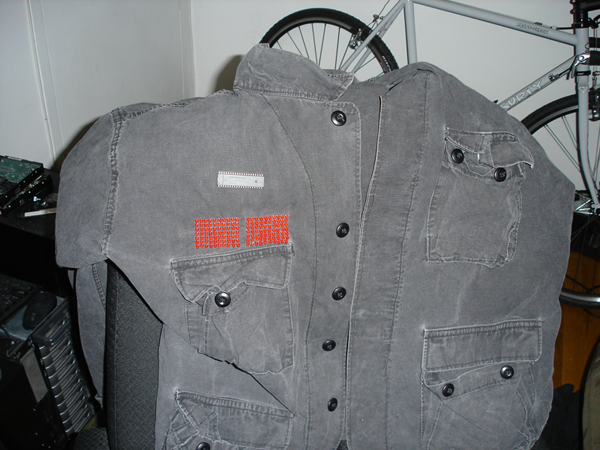LED Array Jacket
Appearance
About
[edit | edit source]This starts out as an LED Array Integrated into an old Jacket I have. The driver IC is a max6952. The LED Array itself is pretty straightforward. Arduino will be used to control the output, as well as integrate future hardware
See it here:
http://www.nycresistor.com/2008/05/19/led-jacket-test/
Status
[edit | edit source]* LED Arrays Completed. * LED Arrays wired to driver IC. * Arduino was wired to the driver IC, until the TSA decided to unwire it. * Rewired again, could use some cleanup. * Rebuilt Left Array due to LED burnout as result of defective resistor on current ref. * Bluetooth module has been acquired, but I have not had time to work with it yet. > Working on Scrolling Code for Display
Test Code for MAX6952 on Arduino
[edit | edit source]// Max 6952 Example Code For Arduino
// Tested on Boarduino
// Matt Joyce @ NYC Resistor
#define DATAOUT 11//MOSI
#define DATAIN 12//MISO - not used, but part of builtin SPI
#define SPICLOCK 13//sck
#define SLAVESELECT 10//ss
char spi_transfer(volatile char data)
{
SPDR = data;
// Start the transmission
while (!(SPSR & (1<<SPIF))) // Wait the end of the transmission
{
};
return SPDR; // return the received byte
}
void setup()
{
byte i;
byte clr;
pinMode(DATAOUT, OUTPUT);
pinMode(DATAIN, INPUT);
pinMode(SPICLOCK,OUTPUT);
pinMode(SLAVESELECT,OUTPUT);
digitalWrite(SLAVESELECT,HIGH); //disable device
// SPCR = 01010000
//interrupt disabled,spi enabled,msb 1st,master,clk low when idle,
//sample on leading edge of clk,system clock/4 (fastest)
SPCR = 0b01010010;
clr=SPDR;
delay(32);
// Configure Register
write_led_twice(0x04,0x01);
// Intensity Pane 1 and Pane 2
write_led_twice(0x01,0xFF);
write_led_twice(0x02,0xFF);
// Scan Limit
write_led_twice(0x03,0x01);
}
byte write_led(int address, int value)
{
digitalWrite(SLAVESELECT,LOW);
//2 byte opcode
spi_transfer(address);
spi_transfer(value);
delay(36);
digitalWrite(SLAVESELECT,HIGH); //release chip, signal end transfer
}
// Write n times for n chips daisy chained.
byte write_led_twice(int address, int value)
{
digitalWrite(SLAVESELECT,LOW);
//2 byte opcode
spi_transfer(address);
spi_transfer(value);
spi_transfer(address);
spi_transfer(value);
delay(36);
digitalWrite(SLAVESELECT,HIGH); //release chip, signal end transfer
}
void loop()
{
// Testing ROM Character Set
write_led_twice(0x20,0x5e);
write_led_twice(0x21,0x5e);
write_led_twice(0x22,0x5e);
write_led_twice(0x23,0x5e);
delay(4000);
// Testing Programmable RAM Space
write_led_twice(0x05,0x80);
write_led_twice(0x05,0x42);
write_led_twice(0x05,0x61);
write_led_twice(0x05,0x51);
write_led_twice(0x05,0x49);
write_led_twice(0x05,0x46);
write_led_twice(0x20,0x80);
write_led_twice(0x21,0x80);
write_led_twice(0x22,0x80);
write_led_twice(0x23,0x80);
delay(4000);
// Gred Test Register Call
write_led_twice(0x07,0x01);
delay(1000);
// Turn off Test Register
write_led_twice(0x07,0x00);
}
Creator
[edit | edit source]Matt Joyce Thanks to all of NYC resistor for support.
